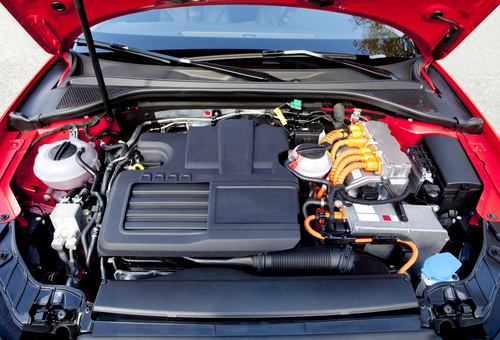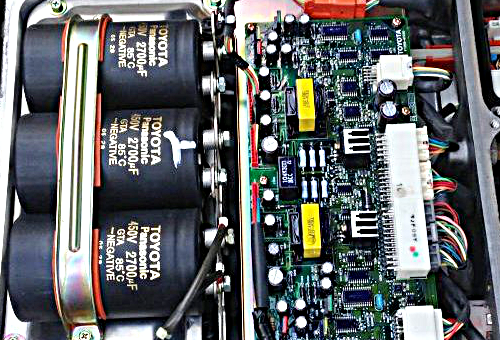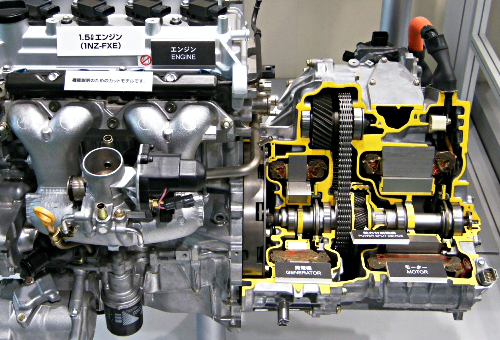
While hybrid vehicles are not as plentiful in the Australian market as they are in the European and North American markets, there are nevertheless a significant number of hybrid vehicles in Australia that are either out of their warranty periods, or are very close to the end of their warranty periods, and ever-higher numbers of hybrids are sold every year.
While this is admittedly not an immediate concern for most Australian technicians, what would you do should an out-of-warranty hybrid roll up to your workshop with an array of warning lights lighting up the dashboard? Would you be able to do even basic diagnostics on the vehicle, or would you simply refer the vehicle to a dealership or a competing establishment? Referring the vehicle might be the best thing to do if you have not had much or any exposure to hybrid technology, but before you do that, let’s take a closer look at the power electronics on older hybrid vehicles in terms of what they do, how they work, and how to diagnose them. Let us start with this question-
Hybrid power electronics are roughly analogous to electronic control modules on conventional vehicles, but unlike control modules that both gather sensor inputs, and transmit control outputs over low-voltage communication networks, hybrid power electronics control and manage voltages and currents that are measured in hundreds of volts and/or amps.
These control and/or management functions are for the most part performed by two modules that are common to all hybrid, plug-in hybrid, and fully electric vehicles. Let us look at these two modules in turn, starting with-

Image source: https://priuschat.com/threads/burning-smell-of-electronics-wont-start.164232/
If you have never seen the inside of a hybrid inverter, this image shows some of the components of a Gen 1 Toyota Prius inverter, which is the type of inverter most non-dealership technicians are most likely to see.
While the primary function of an inverter is to convert DC to AC, and AC to DC when this is required, an inverter's secondary and arguably more important function is to convert high-tension DC from the battery pack into three-phase AC, which is what MG's (Motor-Generators) and electrically-driven A/C compressors require to work. In simple terms, the DC from the hybrid battery pack passes through among other components, six paired IGBT's (Insulated Bipolar Gate Transistors) that both change polarity and switch on and off extremely rapidly, which simulates, rather than creates a high-voltage three-phase alternating current.
Note that the three black cylinders that resemble old-style ignition coils are capacitors that can each store up to 450 volts, which is sufficient to cause fatal electrocution if you are not careful. However, not shown here is three (green) smaller passive resistors whose sole function it is to discharge the primary capacitors after either a system malfunction or after an OEM-prescribed shutdown procedure to facilitate servicing of the system. Be aware though that the time taken to discharge the primary capacitors can vary from a few seconds to several minutes, so do NOT attempt to test, measure, or touch anything in a hybrid inverter without first verifying that the capacitors are discharged.
Also, note that newer inverters contain primary capacitors that look nothing like the ones shown here; therefore, it is important to avoid touching, measuring, or testing anything in these inverters unless you know exactly what you are touching, measuring, or testing, which brings us to-
DC-DC converters on hybrid vehicles are essentially step-down transformers that reduce high-tension DC from the battery pack to between 13 and 15 volts, which is what we are accustomed to seeing conventional alternators develop. This current is used to charge the conventional battery used by the internal combustion engine, as well as by most systems and components that typically require low voltages to work.
Most DC to DC converters reduce high tension currents with a series of coils and advanced solid-state electronics, and while we need not delve into the complexities of this system here, suffice it to say that the DC to DC converter performs the same function that a conventional alternator would perform on a conventional vehicle. Moreover, this charging system on a hybrid vehicle can be checked/diagnosed/tested with a multimeter in the same way one would test a conventional alternator and/or charging system, including applying a load to the 12-volt battery to test its operation or condition.
The above are necessarily brief descriptions of the two principal power electronics components on hybrid vehicles, and as such, these descriptions do not provide enough information to diagnose some common problems on hybrid vehicles. Therefore, the following section is a somewhat simplified breakdown of the principal problems and symptoms you are most likely to encounter on older hybrid vehicles, as well as some diagnostic tips and tricks. Let us start with this-

Image source: https://en.wikipedia.org/wiki/Hybrid_Synergy_Drive#/media/File:Toyota_1NZ-FXE_Engine_01.JPG (Public Domain)
As a general rule, only mild hybrids that use General Motors’ BAS (Belted Alternator Starter) system can be said to use a starter motor. In all other types of hybrids, the ICE is spun by the MG (Motor-Generator) combination using power from the battery pack. Nonetheless, it should be noted that this starting system typically cranks ICE’s at well above 1000 RPM during cranking, and in some cases, the ICE is spun at up to about 1500 RPM during cranking.
In practice, the same MG that cranks the ICE also provides motive power when the vehicle is in purely electric mode, and assuming that the ICE has power to the ignition system, fuel to the injectors, and sufficient cylinder compression, it will typically start within about one second or so. Here is how it works-
When starting is required, the battery pack supplies high-tension power to the inverter, which converts the DC to three-phase AC, which the MG then uses to crank the ICE. However, what you won't notice is the sound of a starter engaging a ring gear; nor will you hear the rhythmic sound of an ICE cranking at about 150 RPM. From even a short distance away, you might not hear anything at all, and if you do hear something, you might confuse the sound of the cranking ICE with the sound of an ICE running at a fast idle.
So if you want to know if the ICE had started and is running under its own power, do one or more of the following-
The causes of ICE no-start conditions are for the most part similar to the causes of no-start conditions on conventional vehicles, so keep the following in mind when you encounter a no-start condition on a hybrid vehicle-
If the ICE cranks but won’t start, it will NOT be due to issues in either the inverter or the DC-DC converter, and here is why-
While any competent technician should be able to resolve normal ICE no-start conditions, there is a somewhat more complex issue on older hybrid vehicles that requires some careful thinking about to diagnose successfully, this issue being-
Since this particular combination of symptoms/issues can have many potential causes, it is easy to become sidetracked or to develop tunnel vision when you are trying to reduce the problem to its simplest form. Sadly, limited space precludes a comprehensive discussion of all possible faults, defects, malfunctions, and failures that have the potential to produce this combination of symptoms on all hybrid vehicles, so to keep things clear and simple, the five main categories of possible causes/issues (along with some sub-faults) are listed below-
High voltage Battery Pack
High voltage Power Distribution*
* Note that on all hybrid vehicles, high voltage power is always distributed via large-diameter cables that are always either orange or red.
High voltage Interlock Failures*
*Note that safety-related issues will almost certainly always be indicated by generic fault codes, the most common of which is P0A0D – “High voltage System Interlock Circuit High”
Motor / Generator
* Note that since the ICE is spun at very high RPM’s during cranking, the torque required to spin the engine is very accurately defined as a means to protect the engine against the effect of, for instance, poor lubrication or hydro-locking caused by over fuelling or excessive oil blow-by during cranking. Therefore, any resistance to cranking in the ICE that exceeds the very narrow allowable torque range may very well cause a “Vehicle will not move / I.C.E. will not crank” condition.
Power Electronics Failures
Working through the above list is a time-consuming affair, but bear in mind that high voltage power leakages are extremely common on all types of hybrid vehicles. Therefore, it helps to start a diagnostic process by documenting and clearing all high-voltage power leak-related fault codes before powering up the vehicle again to see when the fault codes appear. For example-
While the above should suffice to point you in the right direction to diagnose most commonly occurring faults on hybrid vehicles, many issues stem directly from faults, defects, and malfunctions in the hybrid systems'-
It should be noted though that hybrid cooling systems are much more complex than even the most intricate cooling systems on high-end conventional vehicles. In practice, an average hybrid vehicles’ cooling system can have several dedicated coolant pumps, a dozen or more dedicated hoses, and two or more separate heat exchangers- each with dedicated cooling fans and their associated control systems.
Overheating of power electronic components is a common cause of several categories of fault codes, component failures, and/or roadside breakdowns, so be sure to always check for visible signs of coolant leaks, or evidence of overheating of any electronic component(s) when you are diagnosing problems on hybrid vehicles.
Additionally, some cooling systems/circuits on the same vehicle can be filled with different types of coolants, and/or different coolant mixtures, which makes it particularly important to NOT drain, service, refill, or make repairs to ANY part of a hybrid vehicles’ several cooling circuits without first consulting OEM-level service information and/or recommendations. In some cases, you will need dealership-grade software to verify that a particular cooling system/circuit is fully functional, so do not drain and/or refill any hybrid cooling circuit unless you are sure that you can verify its operation after the repair.
Making a mistake while working on hybrid cooling systems/circuits can lead to increased rates of corrosion and/or insufficient cooling rates, both of which have the potential to cause fatal damage to very expensive power electronics components, which leaves us with this-
Hybrid vehicles may appear to be complex, confusing, and perplexing, but when one takes an objective view of the principles that make hybrid vehicles work, it becomes clear that there is nothing exotic or arcane about the underlying technology.
If you have a firm grasp of basic electrical theory you should be able to follow the processes that convert DC power into AC power, which is what provides most of the motive power to a hybrid vehicle. Everything else is incidental to that process and once you understand that, it becomes easier to reduce most issues on hybrid vehicles to their simplest form, which is the basis of all successful diagnostic processes or strategies- regardless of the type of vehicle you are working on.